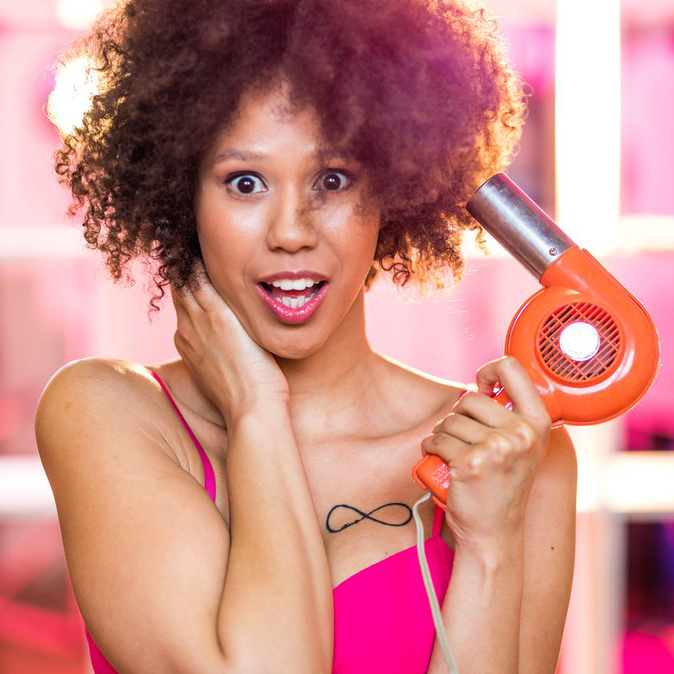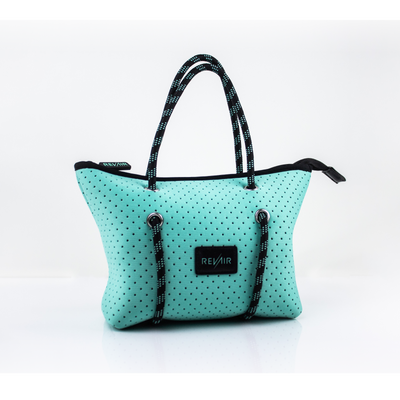
Is Blow Drying Good for Curly Hair? 3 Big Reasons Why You Shouldn't!
As gorgeous as your natural curly locks may be, we understand how sometimes you might just want to rock a straight, sleek style. Your straightening routine probably includes spending 30 to 90 minutes with a blow dryer and a brush to tame your curls.
Using a blow dryer to straighten your curly hair might be fun and a great way to get a new and fresh look, but it carries seriously harsh side effects for your hair's health.
You see, maintaining healthy hair requires avoiding activities that negatively affect your hair, especially when you have natural curls. Before you pick up that high-heat blow dryer, remember that your curly hair is fragile. The harsh heat from blow drying can permanently damage your natural curls, leaving you with unhealthy split ends and permanent breakage.
Before discussing why you shouldn't use a blow dryer for curly hair, we want to provide you with a foundation about the anatomy of hair and the science behind your curls.
THE SCIENCE OF CURLY HAIR

You probably don't spend a whole lot of time thinking about the parts of your hair and the science behind your curls, and you likely don't necessarily need to. You should know the basics, however, so you can understand how a blow dryer can damage your hair.
Whether wavy, straight, or curly, each piece of your hair has a shaft and a follicle. The follicle is the part of your hair that lies beneath your scalp; the shaft is the visible hair flowing away from your scalp. Both the hair shaft and the follicle help determine your overall hair type.
The shape of hair follicles falls along a spectrum with the level of curl. Straight hair has round follicles, whereas very curly hair has flat, oval-shaped follicles. How a hair follicle tunnels (or enters) into the skin also differs between straight and curly hair.
The follicle is a tunnel that travels deep into your skin. Under your skin is where the root of your hair lies. Straight hair follicles tunnel vertically into the skin, while curly hair tunnels in at an angle. This angle causes the hair to grow into a curve as it lengthens, but it can also cause dryness.
You have special glands below your scalp that release your natural oils, which are called "sebum." Your angled follicles make it difficult for these oils to travel up your hair shaft and keep it moisturized.
Your visible tresses include strands (or shafts) of hair that are comprised mostly of dead cells that are full of keratin (yes, all this talk of dead stuff makes your hair sound sexy!), which is a fibrous protein in hair and nails.
A shaft of hair is comprised of three main layers:
The Cuticle. The cuticle is the protective outermost layer of a hair shaft and is made up of overlapping cells. This overlapping structure protects the inner layers of hair and holds the cells together. A healthy cuticle results in shiny hair because smooth cells reflect light.
The Cortex. The cortex is the middle layer of hair and contains long, twisty proteins. Even straight hair will stretch before it breaks because of this structure. Your natural hair pigments are also held in the cortex. When the cuticle is healthy, it protects your hair from damage.
The Medulla.The medulla is the innermost layer (or the core) of the hair shaft. It provides the hair's structure. The medulla also holds the hair's moisture; the cuticle allows moisture to enter and leave. When the medulla is unprotected and damaged, it cannot maintain the proper moisture, which results in dry hair.
The cortex helps determine your hair type in the following way: amino acids, which create the keratin in the cortex, bond with other amino acids on the shaft of the hair. The hair curls up between each of these bonds, creating those vibrant, bouncy curls you were blessed with.
In other words, more bonds mean more curls!
Now that you understand how your hair follicles and shafts contribute to your curly hair, let's take a closer look at the three biggest reasons that you shouldn't use a blow dryer on your curly tresses.
1. HEAT DAMAGES YOUR NATURAL CURLS

Have you ever wondered exactly how the heat from a blow dryer damages your hair?
As explained above, the amino acids are responsible for creating the keratin in your hair. These amino acids bond with each other along the hair shaft, which ultimately results in curls. Using a blow dryer on your curly hair adds heat to those bonds, breaking them in the same fashion as a chemical relaxer would. The heat also damages the cuticle.
Continued heat can expose the innermost layer of your curly hair, causing dryness. Once heat damages the amino acid bonds, they cannot be reformed. Consistent use of a blow dryer destroys natural curl patterns at a molecular level by changing the structure of the protein.
In fact, a blow dryer quickly heats moisture in the hair to its evaporation point. When the water turns to steam, it creates high-pressure bubbles inside the hair shaft, permanently damaging its structure.
If you've ever started to hyperventilate after washing your hair because you have straight pieces hanging out of your head and your natural curl won't return, you have witnessed the aftermath of the structural damage done to your hair from heat.
Now, keep in mind that heat damage to your natural curls differs from chemical damage in terms of time. You can chemically damage your hair in minutes; heat damage from using a blow dryer on your curls is the result of repeated use and worsens over time.
Remember that your tresses are "dead hair." That means that once they are damaged they stay damaged and need to be cut off.
2. BLOW DRYERS CAUSE SPLIT ENDS
Each time you use a blow dryer on your curly hair, you contribute to breakage and split ends. There are far worse things in life you could do; it's not like you're robbing a bank, but we know you want gorgeous hair.
Blow-drying curly hair removes surface moisture and the hydrating water that is chemically bound to your hair, which is found in the medulla. This compounds the dryness you may already experience. That's because your hair follicles' elliptical shape doesn't allow sebum to easily travel up the hair shaft to moisturize it. In turn, your cuticles dry out and become brittle.
When you manipulate brittle hair, it causes the hair cuticles to crack. This results in significant breakage and split ends because the cortex is no longer protected. Split ends are a result of damage to your hair. They can come in multiple shapes, depending on the level of damage.
The first sign of hair damage is the loss of the outer cuticle. Your hair hasn't quite split yet; however, as you continue to use a blow dryer, you will likely begin to see mini-splits and basic split ends.
Mini-Split Ends Versus Basic Splits
A "mini-split" is when a piece of hair separates slightly to look like a small "y." A basic split end is simply the larger version of the mini split. Basic splits indicate that your hair needs some TLC before it is too late.
As damage from blow drying progresses, the ends of your hair shaft might resemble a fork in the road. Eventually, the split will travel up your curl, with little "branches" resembling a tree. When you see these kinds of splits, it's an indication the cuticle has separated from the cortex. When the cortex is unprotected, its fibers fray like the end of a rope.
Even worse, your hair can look like you stuck your finger in a light socket, especially on hot and humid days. After you notice multiple breaks that progress up your hair shaft, you will need to make that emergency trip to your stylist and have them whack off your ends. The cortex won't heal itself.
If you catch split ends at the beginning stages (before you have exposed the cortex or the medulla), you might be able to stop them with a conditioning treatment or some type of sealant that will protect them.
Instead of worrying about catching split ends as they occur, it's better to avoid using a damaging blow dryer altogether. Your hair will thank you!
3. CURLY HAIR IS FRAGILE

You've already learned how your curly hair follicles and hair shafts differ from those of straight hair. These differences ultimately cause curly hair to be more vulnerable to damage, something you likely already know.
The larger structure of a piece of curly hair, including its twists and turns, causes a weaker cuticle and increases knots and tangles.
Mid-Shaft Split Ends
People with all hair types must deal with breakage and split ends, but those with curls have to deal with mid-shaft splits in their hair. The more kinks and coils in your curls, the more bends and twists in each hair shaft.
Each bend and twist are points of weakness in the hair shaft, making these weaknesses prime spots for a mid-shaft split. Like regular split ends, mid-shaft splits can leave your cortex and medulla unprotected and vulnerable to damage.
Now, keep in mind that regular split ends can occur even when you take care of your hair and don't use a blow dryer. The hair at the end of the shaft is the oldest; it will eventually split and require a trim. Mid-shaft splits tell a different story!
Mid-shaft splits are a direct effect of over-manipulating hair and damaging hair with chemicals or heat. When you have curly hair that is already inherently weaker, blow drying your hair not only causes damage on its own but also further weakens hair. This progressively causes more mid-shaft splits.
Common blow-drying practices that can lead to mid-shaft splits include:
Using a Brush

When using a blow dryer on curly hair, many also use a brush. Even the newest fancy detangling brushes can hurt your curls because they brush through little knots, which are common weak points and are common causes of mid-shaft splits.
PUT DOWN THE BRUSH AND STEP AWAY SLOWLY! Finger-detangling won't eliminate the heat damage from using a blow dryer, but it can help avoid breaks from tangles.
Excessive Manipulation
Wet hair is more vulnerable to damage because it is weaker. If you are blow-drying your hair in conjunction with twisting, braiding, and rolling, you are most likely causing breakage that you may not notice until it is too late.
Using Heat
As explained, heat damages your natural curls at a molecular level. Hot styling tools and heat from blow dryers can also cause mid-shaft splits by damaging your hair's cuticle. Using a proper protective sealant on your hair and making sure your hair has been properly hydrated and moisturized can help prevent heat damage from flat irons.
Avoiding Protein Treatments or Too Much Protein
Dryness remains the number one challenge for those with curly hair. One way to overcome dryness beyond a good moisturizing conditioner is to use a protein conditioner or treatment.
When introducing protein to your curls, it attaches to the areas where the shaft is weak, and where the cuticle has started to break away. The hair cuticle allows the protein and moisture to travel through to the cortex and medulla, strengthening your hair.
Some who blow dry their hair regularly use protein treatments to avoid damage. However, did you know that protein overuse also causes damage? Use protein treatments occasionally, or your hair can become damaged from too much protein. Too much protein prevents moisture from traveling between the cuticle and the medulla, resulting in dryness.
Your beautiful curls are fragile. Keep them healthy and beautiful so that your hair also looks healthy and sleek when you decide to wear a straight look. Choosing not to use a blow dryer for your curly hair is one of the best ways to maintain your hair.
PROTECT YOUR CURLY HAIR, VISIT REVAIR
We know you care about maintaining your healthy hair and vibrant curls, but we also know you sometimes like to don sleek, straight looks. When you use RevAir, the world's first and only reverse-air dryer, you can enjoy wearing straight styles without damaging your natural curls.
RevAir uses less heat and less friction to dry your hair straight in less time than a traditional blow dryer. That way, your cuticles stay protected and each hair shaft maintains its necessary moisture. Research has proven that RevAir is faster, easier, and healthier than other hair drying and straightening options, resulting in straighter and sleeker hair with less frizz.
Visit our online store today for more information about our revolutionary product and to order your RevAir. Questions? We hope that you'll reach out with questions about our innovative products or comments about our blog, especially if you would like to see an article on a specific topic!














